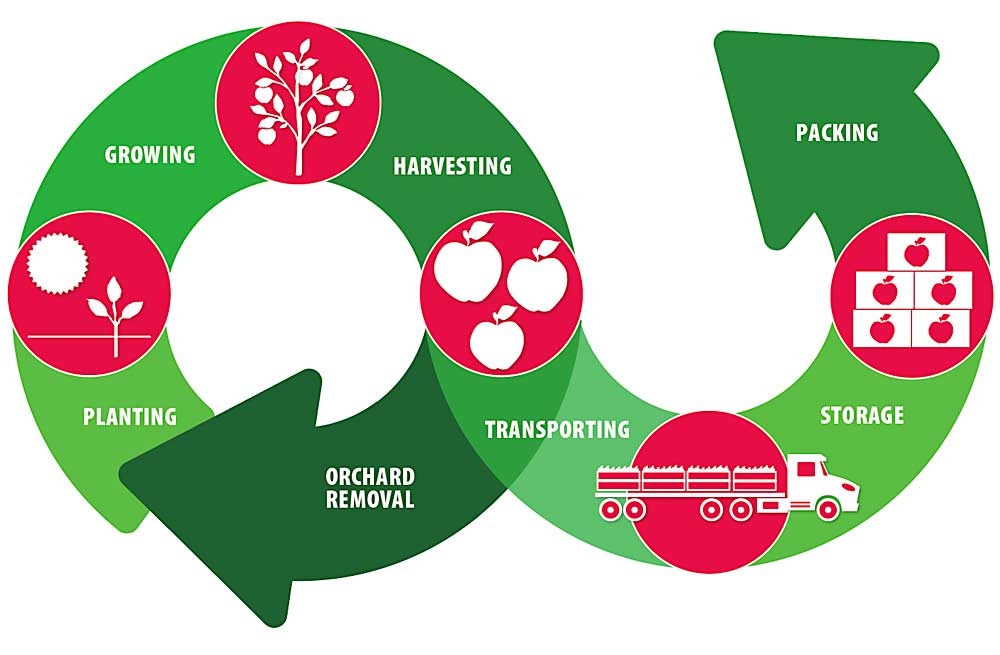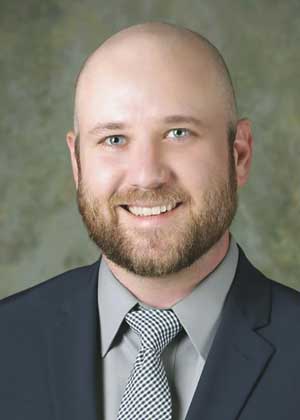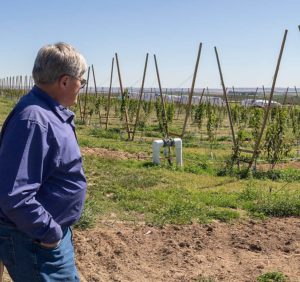
Demand for agriculture to reduce its climate impacts continues to build from regulators, retailers and consumers. Tree fruit growers are committed to finding solutions for their industry through research that quantifies those impacts.
While a handful of climate models for production agriculture have hit the market recently, there is no one-size-fits-all approach. Growers need crop- and region-specific models. An apple orchard in Washington or Oregon grows within different soil types, topography, weather conditions, pest pressures and water and energy availability than an orchard in Michigan or New York.

Current credible, science-based information specific to Pacific Northwest apple production’s carbon footprint is limited. How do conventional and organic growers analyze their operation’s greenhouse gas emissions, on-farm inputs and various production practices, as well as their carbon sequestration potential? To obtain this essential research, the Washington state apple industry is conducting a life cycle assessment, or LCA, and is asking growers for their assistance in building the LCA’s apple production and storage data.
LCA research serves as a foundation for quantifying climate impacts associated with a single production system in a distinct growing region by establishing an accurate baseline. In this case, apple production systems in Washington will be studied “from cradle to gate” — starting with orchard establishment (accounting for orchard removal), then progressing through growing, harvesting, storing and packing. With these baseline input and output measurements in hand, the industry can identify practices that contribute to climate concerns and develop region-specific solutions.
“This LCA will be beneficial to factually demonstrate the environmentally positive aspects of our region’s apple industry,” said Brent Milne, assistant orchard manager at McDougall and Sons in Wenatchee, Washington, and chairperson of the Northwest Horticultural Council’s climate change subcommittee. “If we don’t do this, someone else will. Or, even worse, they will use studies that have no basis for standing in our actual activities and growing conditions.”
Milne said, with this LCA project funded by the Washington Tree Fruit Research Commission, the tree fruit industry can own and manage its climate data. A team of advisors from the Northwest Horticultural Council, Washington State Tree Fruit Association, Washington State University, grower-packer companies and consultants assisted in developing the grant proposal. The research commission awarded the project’s full funding of $500,000 in February. The same team will serve as an advisory panel throughout the three years of the study.
Lead principal investigator of the apple LCA is Greg Thoma, director of agricultural modeling and life cycle assessment at Colorado State University. The co-principal investigators are WSU and Blonk Sustainability Tools, a Netherlands-based research firm that developed a tool for Dutch fruit growers to measure their carbon footprint.
By collaborating with WSU, the LCA investigators can utilize the climate research expertise at the university’s Center for Sustaining Agriculture and Natural Resources.
“We’ve been working on assessing the carbon footprints of Pacific Northwest agricultural production systems for two decades, but we’ve never investigated tree fruit systems until now,” said Chad Kruger, director of the center. “Until recently, most of the interest in carbon in agriculture had been in grain and livestock production systems, not specialty crops.”
CONDUCTING A LIFE CYCLE ASSESSMENT
Year 1: Collect data
—Growers fill out production survey, researchers interview orchard managers.
Year 2: Analyze data and run field tests
—Researchers use production data to create an input-output matrix for the apple supply chain, quantify raw materials use and construct life cycle inventory.
Year 3: Evaluate results and develop analysis tool
—International Organization for Standardization (ISO) reviews LCA, showing results are robust and provide effective methods for apple producers to address climate concerns.
—Team creates spreadsheet-based scenario analysis tool growers can use to assess carbon footprints.
TIMELINE
December 2022
Grant proposal submitted to Washington Tree Fruit Research CommissionFebruary 2023
WTFRC funding awardedJuly–November 2023
Grower-packer interviews conductedJanuary–March 2024
Industrywide survey goes out2024–2025
Data analysis and baseline modeling2025–2026
ISO review and environmental footprint tool
Kruger said when the Northwest Horticultural Council approached him about exploring an LCA for apples, he recommended connecting with Thoma.
Thoma said the first year of the study requires the collection of extensive production data. This is accomplished through one-on-one interviews with orchard managers, which took place over the summer and continue this fall. Next, a survey will ask industry members to answer questions about apple production representative of their overall operation. Keep an eye out for this in early 2024.
“The first stage of the project — the grower survey — is critical because it represents the foundation of the entire study through the collection of representative and accurate data regarding the inputs and activities associated with apple production across the full life cycle of an orchard,” Thoma said.
Significant safeguards are in place to protect growers’ privacy and confidentiality, including by aggregating the data horizontally and vertically.
The second year of the study involves data analysis and field tests informed by the survey data. During the third year, Thoma and his team will develop a “scenario analysis tool” for apple growers. Thoma said the spreadsheet-based tool “will enable individual producers to customize inputs to match their specific situation and calculate sustainability metrics (such as a carbon footprint) for their operations.”
By identifying practices that may negatively impact climate, mitigation options and alternative practices specific to the Pacific Northwest can be developed and shared with retailers and regulators. This may include opportunities for greenhouse gas reductions, farm input optimization, water and soil conservation, and transportation efficiencies. But, as both Milne and Thoma said, to get the most out of the LCA, apple industry members must provide the best information possible.
“The old adage ‘garbage in, garbage out’ is particularly appropriate in every exercise of life cycle assessment,” Thoma said. “The usefulness of the study is strongly dependent upon the availability of high-quality, representative data from producers in the region.”
If the survey receives broad industry participation in early 2024, the LCA advisory team is confident the study will substantiate climate-smart practices already in place — as well as identify areas that need improvement. This could potentially include sequestering carbon through the growth of trees, protecting against soil erosion and nutrient runoff with vegetation between tree rows, decreasing water usage via targeted irrigation systems, and supporting other methods growers employ to make the most efficient use of resources and raw material inputs.
The LCA baseline data and subsequent analysis tool will help apple growers meet climate-related retailer directives already entering the marketplace and government mandates potentially around the corner. Additionally, growers will be better prepared to: participate in voluntary government incentive programs; develop future industry research priorities; inform the public of their work to contribute to climate change solutions; and demonstrate their collaborative and forward-thinking approach to difficult issues.
“The LCA can tell the real story of apple production in Washington and the benefits of having a robust apple industry,” Milne said.
This study is a testament to the Pacific Northwest apple industry’s efforts to best understand the climate impacts of its production, engage in problem-solving activities wherever possible and make practical adjustments that promote good stewardship of land, water and other critical resources in a climate-challenged world.
—by Dan Langager
Dan Langager is the technical communications manager of the Northwest Horticultural Council. Based in Yakima, Washington, the NHC represents the growers, packers and shippers of apples, pears and cherries in Washington, Oregon and Idaho on federal and international policy and regulatory issues.







Leave A Comment